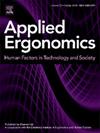技术辅助和自我导向干预措施对印度办公室员工少坐多动的有效性:一项三臂随机对照试验(SMART-STEP试验)。
IF 3.4
2区 工程技术
Q2 ENGINEERING, INDUSTRIAL
引用次数: 0
摘要
这项分组随机对照试验评估了技术辅助计划在印度上班族中以体力活动取代久坐时间(ST)的效果。共有 136 名久坐工作者被随机分为两个干预组:技术辅助组(SMART)和自我指导组(TRADE),以及一个对照组。SMART 组使用一款智能手机应用程序,其中包含每小时运动视频提示和计步器;TRADE 组则收到一本健康手册,其中包含减少久坐和增加运动量的策略。分别在基线、3 个月和 6 个月时使用加速度计对 ST 和 PA 水平进行评估。在 3 个月(β = -0.340,p = 0.015)和 6 个月(β = 0.114,p = 0.030)时,SMART 组的 ST(6 分钟/天)略有减少。但在 6 个月后,TRADE 组的改善并不持久(β = 0.105,p = 0.064)。两个干预组的依从性都明显下降(n = 57,63 %)。未来的试验应纳入组织层面的策略,以提高依从性。本文章由计算机程序翻译,如有差异,请以英文原文为准。

Effectiveness of technology-assisted and self-directed interventions to sit less and move more among Indian desk-based office workers: A three-arm cluster randomised controlled trial (SMART-STEP trial)
This cluster-randomized controlled trial evaluated the effectiveness of technology-assisted programs in replacing sedentary time (ST) with physical activity (PA) among Indian office workers. A total of 136 sedentary workers were randomized into two intervention groups: technology-assisted (SMART) and self-directed (TRADE), along with a control group. The SMART group used a smartphone app featuring hourly exercise video prompts and a pedometer, while the TRADE group received a wellness manual with strategies for reducing ST and increasing PA. ST and PA levels were assessed using accelerometers at baseline, 3 months, and 6 months. The SMART group showed a marginal reduction in ST (∼6 min/day) at 3 months (β = −0.340, p = 0.015) and 6 months (β = 0.114, p = 0.030). But the improvements were not sustained at 6 months in TRADE group (β = 0.105, p = 0.064). A significant decline in compliance (n = 57, 63 %) in both intervention groups. Future trials should incorporate organizational-level strategies to enhance compliance.
求助全文
通过发布文献求助,成功后即可免费获取论文全文。
去求助
来源期刊

Applied Ergonomics
工程技术-工程:工业
CiteScore
7.50
自引率
9.40%
发文量
248
审稿时长
53 days
期刊介绍:
Applied Ergonomics is aimed at ergonomists and all those interested in applying ergonomics/human factors in the design, planning and management of technical and social systems at work or leisure. Readership is truly international with subscribers in over 50 countries. Professionals for whom Applied Ergonomics is of interest include: ergonomists, designers, industrial engineers, health and safety specialists, systems engineers, design engineers, organizational psychologists, occupational health specialists and human-computer interaction specialists.
 求助内容:
求助内容: 应助结果提醒方式:
应助结果提醒方式:


